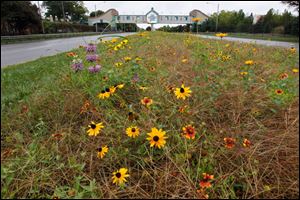
Anthony Wayne Trail median goes native
Toledo Zoo's 'Wild Toledo Prairie Initiative' seeks natural habitats
10/9/2013
The native plants at the Toledo Zoo Anthony Wayne Trail median in Toledo, Ohio.
The median dividing the Anthony Wayne Trail near the Toledo Zoo has been unmowed for so long, a driver is likely to suspect that it’s by design, not default.
True. It’s part of a new project, Wild Toledo Prairie Initiative, in which the Toledo Zoo is eliminating grass and sowing seeds of prairie plants that are native to our area. Some of the 33 species, such as black-eyed susan and Indian blanket, are blooming, and others will flower in spring and summer.
“It hopefully will become aesthetically pleasing,” said Kent Bekker, Wild Toledo project coordinator.
It began this summer with a modest 3.8 acres in four sites, said Mr. Bekker, and will be gradually expanded. In addition to the 1.1 acre median in the Trail (in conjunction with the city of Toledo), the zoo has planted a fenced-in, unused hill on Broadway Street next to the Maumee River, and green spaces at its employee parking lot and warehouse, totaling 2.7 acres.
“All of these areas were places we were mowing for no real reason,” he said.
Native plants, those that flourished here before European settlers introduced species, often invasive, from their homelands, provide several benefits. They increase animal diversity including native pollinators such as butterflies, bees, and birds. They provide educational opportunities, manage rain and runoff better than turf grass, and eliminate the need for mowing, saving human and fossil resources.
“There is less native habitat in a city for native pollinators,” he said. “Even a few of these plants can have a dramatic impact.”
For school groups and summer camps, the teaching component of these living laboratories will demonstrate habitat restoration; monitor small mammals, amphibians, and reptiles that use the spaces, and measure the differences the plantings make. Snakes and lizards such as the five-lined skink and Butler’s garter snake have recently been spotted on some of the zoo’s replanted properties, he said.
Zoo director Jeff Sailor said he’s interested in urban ecology and the ways it can increase biodiversity. Cost for the first year was $15,000, and he expects future costs to be a few hundred dollars. Zoo volunteers will help weed out invasive plants which can crowd out natives, he said. And the perimeter of the newly planted median on the Trail continues to be mowed by the city so that disabled cars can pull over safely.
Hired to install the plants was Ohio Prairie Nursery of Hiram, Ohio. They applyied two applications of herbicide to kill previous vegetation, then installed a custom native seed mix, tweaked by zoo horticulturalists who added five non-native annual flowers for color this year. The mix contained some oats to green up the areas and prevent soil and seed erosion. Seed plugs were pushed into the ground by a tractor pulling a seed drill and a lawn areator.
Maturation is expected to take three years, said Mr. Bekker. Among the plants we can expect to see are little bluestem, partridge pea, cone flower, butterfly weed, ox eye sunflower, New England aster, wild indigo, great lobelia, foxglove beardtongue, and many others.
“In the future we’d like to do more of this in the Toledo area,” he said, adding that zoo staff have long monitored animals in the region such as the rare Blanding’s turtle.
In a report for staff Mr. Bekker wrote: “The median planting is a critical step in experimenting with this form of land conversion in Lucas County. When successful, we are hopeful this could be used elsewhere in the county.”
Contact Tahree Lane at tlane@theblade.com and 419-724-6075.